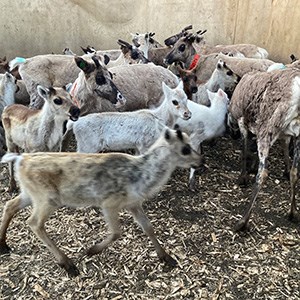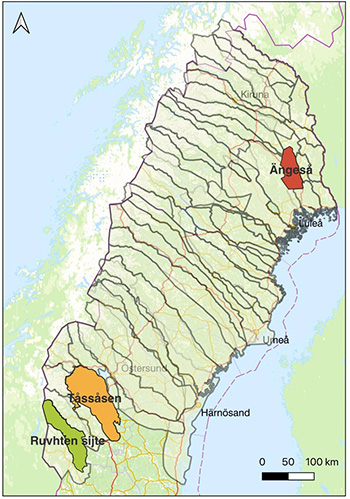Facts:
The project runs 2023–2027 and is financed by the research council Formas.

The purpose of EQUIP is to monitor the survival and mortality of reindeer calves in cooperation with reindeer husbandry in order to find causes of losses of calves from calf marking to slaughter. In the project we will try to find solutions and develop tools together with reindeer husbandry that can be used to deal with the effects of the climate crisis and other land uses.
In recent years, several Sámi reindeer herding communities in Norrbotten have reported high losses of reindeer calves (40-70%) from calf marking at the end of June until slaughter in November. The high losses do not seem to be explained by predators killing the reindeer, even though the number of predators has increased significantly in the reindeer herding area over the past 40 years and many herding communities are suffering from reindeer losses to predators. During late summer, grazing is usually good and the calf is big enough to escape predators. There may be several reasons for increased calf loss, but increased disturbance and stress and poor-quality pastures lead to poorer growth and lower body condition, which in turn can increase the susceptibility of reindeer calves to infectious diseases, including climate-sensitive pathogens.
These cumulative pressures may thus result in a "perfect storm" risking driving the herds towards collapse. Good body condition, demographic stability, and genetic variability in a population may be a way to cope with increased pressures. The climate change thus requires a social-ecological system perspective operating on several spatial and temporal scales. The aim of EQUIP is, in collaboration with reindeer herding communities, to monitor calf mortality and survival and address links to predation, parasites, infectious agents, competing land use and genetic variation, and to seek solutions to alleviate the negative pressures on reindeer husbandry.
In the project, we do a comparative study between three Sámi reindeer herding communities, one with large losses where the cause is unknown (40-70%), one with large losses to predators (30-50%) and one where the losses are low (5-10%), but there is a relatively high proportion of parasites (50%) documented at slaughter. The reindeer calves will be equipped with GPS and mortality collars, which send out signals when they stop moving. Then the calves can be quickly found again and it will be possible to determine the cause of death. We also weigh the calves, take blood samples to detect infectious agents and we collect faeces to document parasites. We will analyse the reindeer DNA to find out the genetic variation between different reindeer herds and how resistant they are to diseases. From GPS data on the calves, we will be able to analyse movement patterns and habitat selection and find out how they have reacted to high insect activity and other disturbances in the grazing area and we will seek to find solutions to problems such as increased stress from insect disturbances.
In Sweden, the government decided in 2013 on a tolerance level of 10% losses of live animals to predators should be an acceptable level. Still, there are problems in the reindeer husbandry area with higher losses, both to predators, and as it seems, to other still unknown factors. Knowledge from the mortality studies in EQUIP will feed into the management of predators and the work on tolerance levels for reindeer husbandry in Sweden.
Anna Skarin, anna.skarin@slu.se
The project is a collaboration between the participating Sámi reindeer herding communities Ängeså, Tåssåsen and Ruvhten Sijte in Sweden, Sámiid Riikkasearvi (SSR) and a number of researchers at SLU and other universities in Sweden and Norway – Prof. Anna Skarin, Prof. Lars Rönnegård, Dalarna University, Docent Per Sandström and Docent Sven Adler at Forest resource management, SLU, Peter Halvarsson at Animal biosciences, SLU, Prof. Anna Qvarnström, Uppsala Univsersitet, Prof. Øystein Holand at Norwegian University of Life Sciences, Prof. Morten Tryland Innlandet University, Norge, Dr Ingebjørg Nymo and Dr Rebecca Davidson, Reindeer health services, Norweigan veterinary institute, Norge, Ulrika Rockström Farm and Animal Health, Anna-Marja Kaddik, SSR. Sami Parlament, County boards of Norrbotten and Jämtland, Swedish Environmental Protection Agency and Wild life damage center, SLU are represented in the reference group for the project. The project leader is Professor Anna Skarin, at the Department of Applied Animal Science and Welfare, SLU.

Participating Sami reindeer herding communities that are studied in the project:
1. Ängeså (Norrbotten)
2. Tåssåsen (Jämtland)
3. Ruvhten (Jämtland)
The project runs 2023–2027 and is financed by the research council Formas.